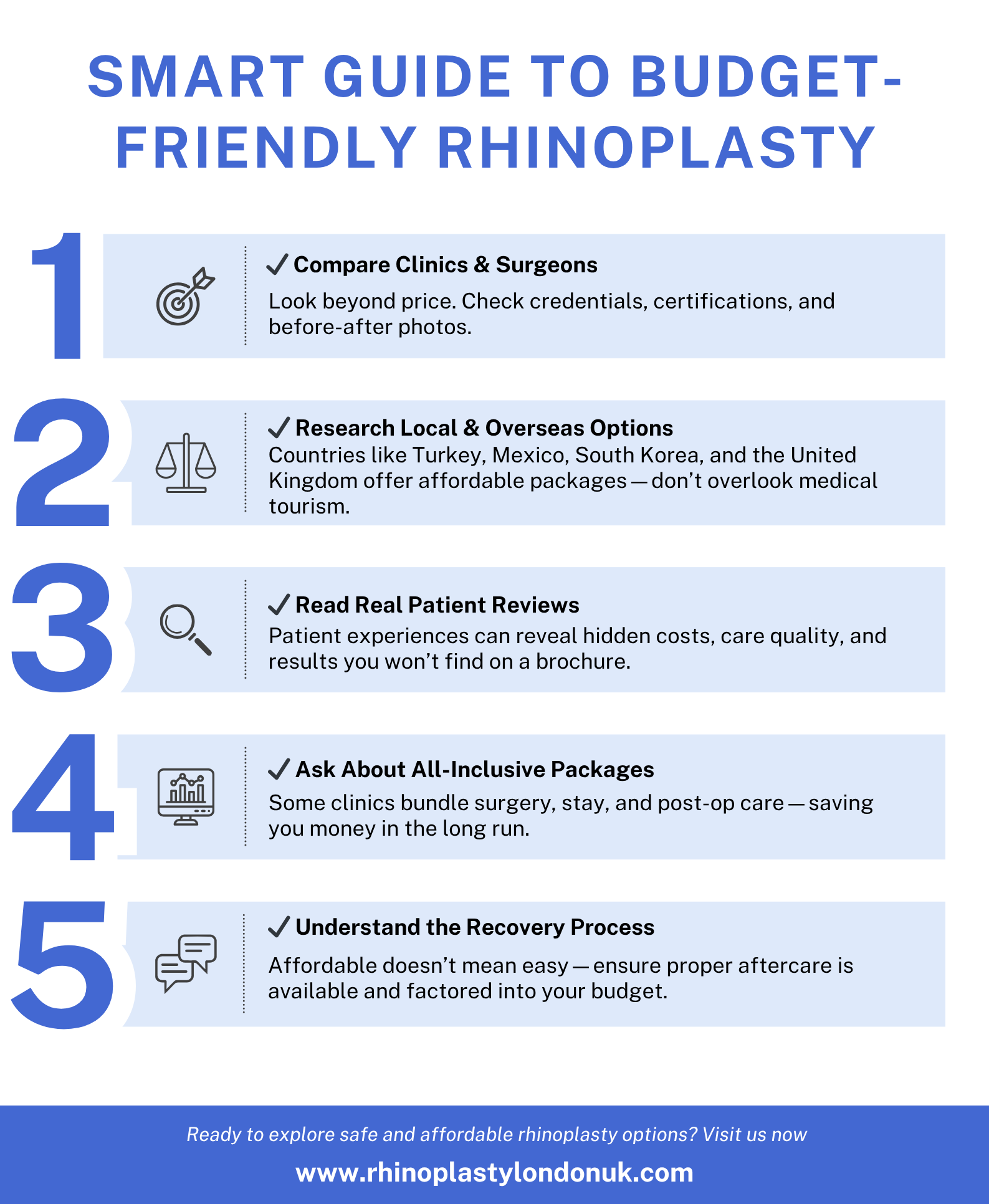Many people want to improve their appearance with rhinoplasty but find the upfront price tag a bit daunting. Good news! There are ways to make it more affordable, especially by looking into payment plans.
This article will help you figure out how to pay for rhinoplasty in instalments, breaking down everything from understanding the costs to finding ways to spread out your payments.
Key Takeaways
- Rhinoplasty costs vary based on many things, like the surgeon’s experience and where the clinic is located.
- Many clinics and medical finance companies offer payment plans, letting you pay for your nose job over time.
- Personal loans and credit cards can be options, but make sure you understand the interest and terms.
- Sometimes, health insurance might cover part of the cost if the surgery is for medical reasons, not just cosmetic.
- Always get a clear, full price breakdown, including all pre- and post-operative care, to avoid surprises.
Understanding Rhinoplasty Costs

One of the first things on your mind is probably the cost. Let’s break down what you can expect to pay and why the prices vary.
Factors Influencing Rhinoplasty Pricing
Loads of things can affect how much you’ll end up paying for your rhinoplasty. The surgeon’s experience is a big one – more experienced surgeons usually charge more. Where you’re located also matters; prices in London will likely be different than in a smaller town.
The type of rhinoplasty you need (like if it’s just cosmetic or also fixing breathing issues) and the complexity of the surgery all play a role too. Don’t forget about the anaesthetist’s fees and the cost of using the surgical facility.
Typical Cost Breakdown of a Nose Job
Okay, let’s get down to numbers. A typical rhinoplasty might include:
- Surgeon’s fee: This is usually the biggest chunk.
- Anaesthesia fee: Depends on how long the surgery takes.
- Facility fee: Covers the cost of using the operating room and recovery area.
- Pre-operative tests: Blood tests, etc.
- Post-operative care: Medications, follow-up appointments.
The total can vary quite a bit, but it’s good to have an idea of where your money is going.
Comparing Surgical and Non-Surgical Options
Surgical rhinoplasty is the traditional nose job, involving incisions and reshaping of bone and cartilage. Non-surgical rhinoplasty, also known as a liquid nose job, uses fillers to make small changes to the shape of your nose.
Non-surgical options are generally cheaper upfront, but the results aren’t permanent, so you’ll need to get them redone every year or so. Surgical rhinoplasty is a bigger investment, but the results are usually long-lasting.
Exploring Flexible Payment Plans
Some clinics get that paying for a nose job in one go is tricky. They might offer their own payment plans, letting you spread the cost over several months or even a year. It’s worth asking about this directly when you have your consultation.
These plans can be pretty good because they’re tailored to the clinic’s pricing and policies. Just make sure you understand the interest rates and any fees involved.
Medical Financing Companies
There are companies that specialise in financing medical procedures, including cosmetic surgery. They act as a middleman, providing you with a loan to cover the cost of your rhinoplasty. You then pay the finance company back in instalments.
The good thing is that these companies often have competitive interest rates and flexible repayment terms. However, it’s important to shop around and compare different lenders to find the best deal. Check their eligibility criteria, interest rates, and any penalties for late payments.
Benefits of Staged Payments
Choosing a payment plan, where you pay in stages, has some real advantages. The most obvious one is that it makes the procedure more affordable in the short term. Instead of having to save up a huge lump sum, you can budget for smaller, regular payments.
This can reduce financial stress and allow you to get the procedure sooner rather than later. Plus, some plans might even let you start the payment process before the surgery, giving you time to adjust your finances. It’s all about making the whole thing less overwhelming.
Spreading the cost of rhinoplasty can make it more accessible. It allows for better budgeting and reduces the immediate financial burden. This approach enables individuals to prioritise their health and well-being without significant upfront strain.
Leveraging Personal Finance Solutions
If you’re not keen on clinic payment plans or medical finance, don’t worry. There are other ways to make it happen. Let’s explore some personal finance options that might just work for you.
Utilising Personal Loans for Cosmetic Surgery
Personal loans can be a solid option. They offer a lump sum that you repay in fixed monthly instalments, making budgeting easier. The good thing is that you can often find loans specifically for cosmetic procedures.
Just shop around and compare interest rates and repayment terms. It’s worth checking with your bank or credit union first, as they might offer preferential rates to existing customers. Remember to factor in any arrangement fees or early repayment charges. It’s all about finding a loan that fits comfortably within your budget.
Credit Card Considerations for Rhinoplasty
Using a credit card for rhinoplasty? It’s doable, but proceed with caution. Credit cards can be useful for smaller amounts or if you can pay the balance off quickly. Look for cards with 0% introductory offers on purchases. This can give you a window to pay off the cost without accruing interest.
However, if you can’t clear the balance before the promotional period ends, the interest rates can be pretty high. Also, consider your credit limit and how the purchase will affect your credit utilisation ratio. High credit utilisation can negatively impact your credit score.
Saving Strategies for Your Procedure
Saving up might seem like a slow burn, but it’s often the most financially sound approach. Here are a few ideas to get you started:
- Set a target: Work out the total cost of the rhinoplasty, including consultation fees, the procedure itself, and aftercare. Then, break it down into manageable monthly savings goals.
- Automate your savings: Set up a standing order to transfer a fixed amount from your current account to a savings account each month. This way, you’re less likely to spend the money.
- Cut unnecessary expenses: Review your spending habits and identify areas where you can cut back. Small savings can add up over time. Maybe skip that daily latte or cancel unused subscriptions.
Saving for a big expense like rhinoplasty requires discipline, but it’s totally achievable. Start small, stay consistent, and celebrate your milestones along the way. You’ve got this!
Navigating Insurance Coverage
Okay, so insurance and cosmetic surgery… it’s a tricky one. Most of the time, health insurance won’t cover a rhinoplasty if it’s purely for cosmetic reasons. But, there are exceptions. If your nose job is needed to fix breathing problems or correct damage from an injury, you might be in luck.
Let’s break down how to approach this.
When Health Insurance May Cover Rhinoplasty
Right, so when might your insurance actually pay up? Well, if you’ve got a seriously blocked nose due to a deviated septum, or if you’ve had an accident that’s left your nose a bit wonky and causing breathing issues, then you’ve got a better shot.
The key thing is to prove it’s medically necessary, not just something you want to change for looks. Basically, if you can show that the surgery will improve your health, rather than just your selfie game, you’re on the right track.
Documentation Required for Medical Necessity
So, you reckon you’ve got a case for medical necessity? Get ready for some paperwork. You’ll need:
- A detailed report from your GP or a specialist explaining the medical problem.
- Before-and-after photos (if it’s a correction of an injury).
- Breathing test results (if it’s a breathing issue).
- A letter from the surgeon explaining why the surgery is needed.
Basically, the more evidence you can gather, the better. It’s all about building a solid case to show your insurance company that this isn’t just a whim.
Appealing Denied Claims
Right, so you’ve jumped through all the hoops, sent in all the paperwork, and they’ve still said no? Don’t lose hope just yet! You’ve got the right to appeal their decision.
Here’s what to do:
- Find out exactly why they denied the claim. Get it in writing.
- Gather more evidence. Can you get a second opinion from another doctor? More test results?
- Write a formal appeal letter. Clearly explain why you disagree with their decision and include all your supporting documents.
- Know your policy. Understand the fine print of your insurance policy. There might be clauses that work in your favour.
Appealing can be a pain, but it’s worth it if you genuinely believe you have a valid claim. Sometimes, insurance companies hope you’ll just give up, so don’t let them off that easily!
Finding Affordable Rhinoplasty Options

Rhinoplasty can be a significant expense. But don’t let that immediately put you off. There are definitely ways to make it more affordable and within reach. It’s all about doing your homework and being smart about your choices.
Researching Clinics with Competitive Pricing
First things first, shop around. Don’t just settle for the first clinic you find, even if they have amazing reviews. Different clinics have different overheads and pricing structures, so it pays to get several quotes. Contact multiple clinics and ask for a detailed breakdown of their costs.
Don’t be afraid to ask about any potential discounts or special offers they might have. Some clinics might offer reduced rates during certain times of the year, or for specific types of procedures. It’s also worth checking if they have any package deals that could save you money.
Considering Rhinoplasty in Different Locations
Clinics in major cities, like London, tend to be more expensive than those in smaller towns, such as St Albans, or more rural areas. If you’re willing to travel, you could potentially save a significant amount of money.
Just make sure you factor in the cost of travel and accommodation when you’re comparing prices. And, of course, make sure the clinic you choose is reputable and has experienced surgeons, regardless of its location.
Package Deals and Promotional Offers
Keep an eye out for package deals and promotional offers. Some clinics offer packages that include the surgery, anaesthesia, and aftercare, which can work out cheaper than paying for each item separately. Others might have special promotions running at certain times of the year, such as discounts on consultations or procedures.
It’s always worth asking if there are any deals available when you contact a clinic. Just be sure to read the fine print carefully and make sure you understand exactly what’s included in the package or offer. Don’t be afraid to ask questions if anything is unclear.
Remember, the cheapest option isn’t always the best. It’s important to prioritise quality and safety over price. Make sure you choose a qualified and experienced surgeon, even if it means paying a bit more. Your health and well-being are worth the investment.
Here are some things to consider when looking at package deals:
- What exactly is included in the price?
- Are there any hidden costs?
- What is the surgeon’s experience and qualifications?
- What is the clinic’s reputation?
Preparing for Your Rhinoplasty Investment

This isn’t just about the surgery itself; it’s about the whole journey, from the initial consultation to rocking your new look. Let’s break down what you need to think about to make sure you’re financially and practically ready.
Budgeting for Pre and Post-Operative Care
Okay, so you’ve got a rough idea of the surgery cost. But hold on, there’s more to it than that! Don’t forget the bits before and after the main event. Pre-op, you might need specific skincare products or supplements recommended by your surgeon.
Post-op? Pain meds, follow-up appointments, and maybe even some time off work to recover properly. All this adds up. I didn’t factor in the cost of the special pillow you might need to keep your head elevated after your surgery.
Here’s a quick checklist to get you started:
- Consultation fees
- Medications (pain relief, antibiotics)
- Specialised skincare products
- Follow-up appointments
- Time off work (lost income)
Understanding All-Inclusive Pricing
Some clinics offer all-inclusive packages, and these can seem really appealing. They often bundle the surgeon’s fee, anaesthetist’s fee, hospital costs, and some aftercare into one price. Sounds simple, right? But always, always read the fine print.
Find out exactly what’s included and, more importantly, what’s not. Are there limits on the number of follow-up appointments? What happens if you need extra care? Knowing this upfront can save you from nasty surprises later on.
Conclusion
Getting a nose job might seem like a big financial hurdle, but it doesn’t have to be. There are plenty of ways to spread out the cost, from payment plans offered by clinics to personal loans and even medical credit cards. Many places also offer free initial consultations, which can be a great way to explore your options without committing upfront. The main thing is to do your homework, talk to different clinics, and figure out what works best for your situation.
Don’t let the upfront price tag stop you from looking into something that could really make a difference for you. With a bit of planning, your dream nose could be closer than you think.
Frequently Asked Questions
What affects the overall cost of a nose job?
The price of a nose job can change a lot. It depends on things like how complicated the surgery is, the surgeon’s experience, where the clinic is located, and what fees are included. You’ll need to think about the surgeon’s fee, anaesthesia costs, and hospital charges.
Can I pay for my rhinoplasty in smaller, regular payments?
Yes, many clinics offer payment plans that let you pay for your rhinoplasty over time. You might also look into special medical finance companies or even use a personal loan from a bank.
Will my health insurance help pay for a nose job?
Usually, health insurance won’t pay for a nose job if it’s just for looks. But if the surgery is needed for a medical reason, like to help you breathe better or fix an injury, then your insurance might cover some of the costs.
How can I find a nose job that doesn't cost too much?
To find a good price, you should look at different clinics and compare their costs. Sometimes, clinics in different areas might charge less. Also, ask about any special deals or packages they might have.
What extra costs should I think about when planning for rhinoplasty?
When you’re planning your budget, remember to include money for check-ups before and after the surgery, any medicines you’ll need, and possibly special care during your recovery. Make sure you understand what’s included in the total price the clinic gives you.
Why is a consultation important before deciding on rhinoplasty?
A consultation is important because it lets you talk to the surgeon about what you want and what’s possible. They can tell you about the procedure, the risks, and the total cost. It’s a key step to make sure you’re making the right choice.




